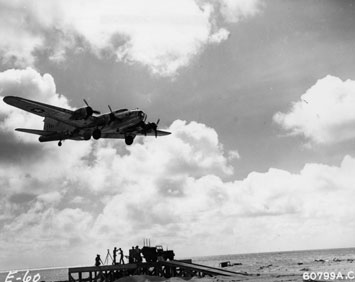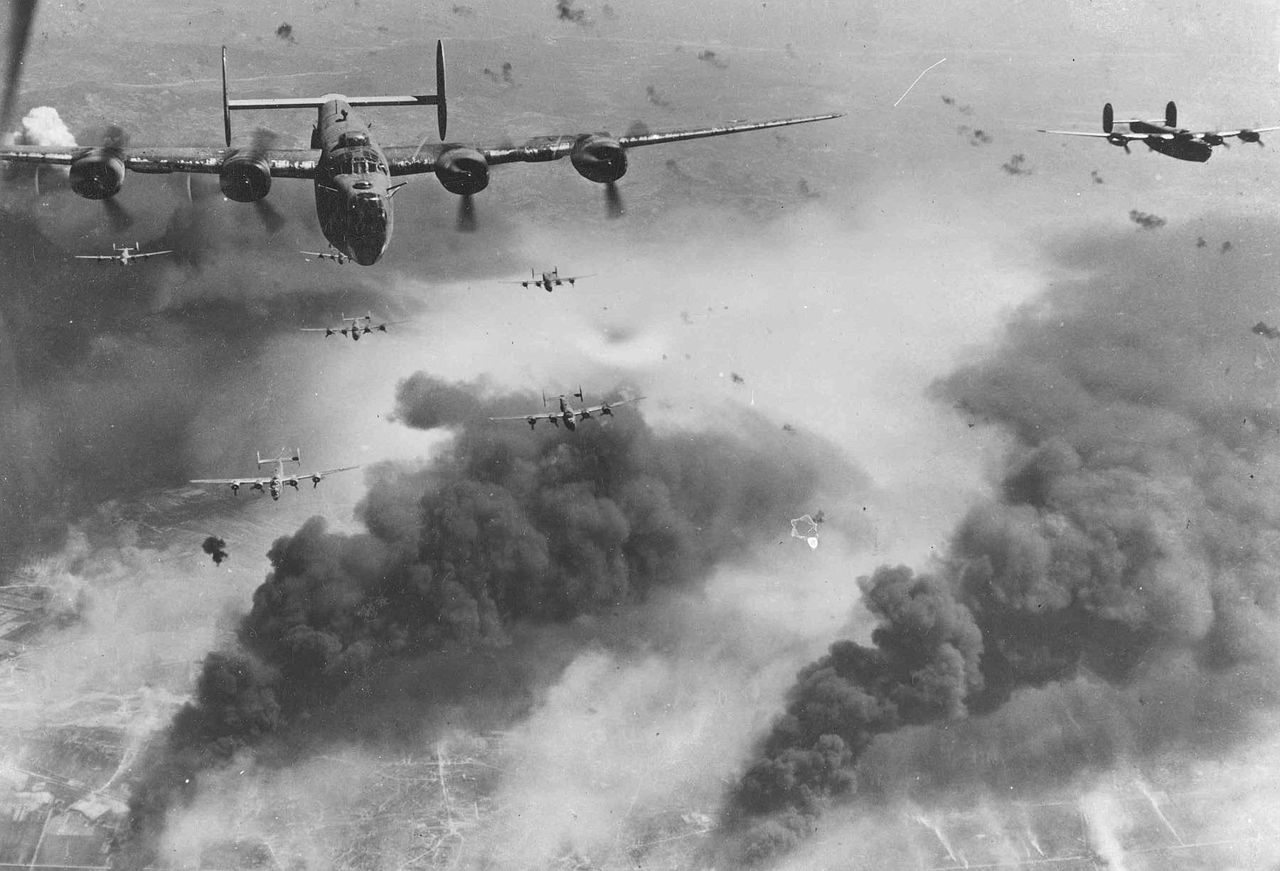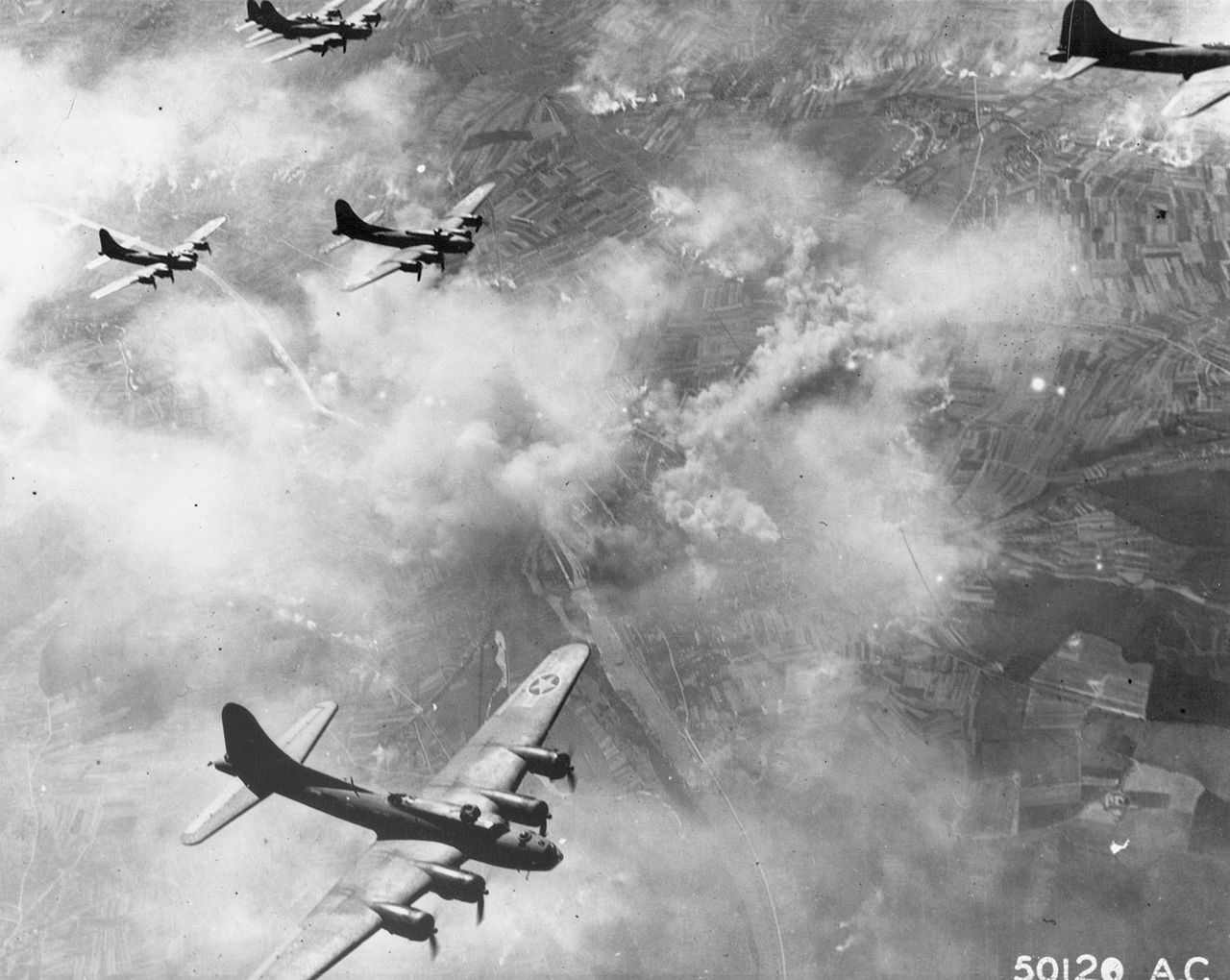The Special Weapons Branch of the Equipment Lab at Wright Field, Ohio, came up with the concept of turning existing airplanes into power-driven controlled bombs in January 1944
At Wright Field, Ohio’s Special Weapons Branch of the Equipment Lab, the concept of transforming existing airplanes into power-driven, controlled bombs first surfaced in January 1944.
The original plan was to employ C-47 transport planes or attack gliders, carrying 10 tons of high explosives, according to Steven J. Zaloga in his book American Guided Missiles of World War II. The USAAF Engineering Division’s Materiel Command expanded the idea to cover a range of bombers, such as the B-24 and B-17. On March 25, 1944, the program was fully launched with the creation of twelve conversion kits. The guidance system was based on the aircraft’s autopilot.
A two-man crew would pilot the aircraft during the initial phase, and once cruising altitude was reached, activate the autopilot and bailout. Then, using a radio-control system, a supporting control aircraft would direct the aircraft toward the target. Any unnecessary weight, such as gun turrets, would be removed from the aircraft. The combat theater enthusiastically supported the program. The commander of the 8th Air Force, Lt. Gen. James Doolittle, proposed using old “Weary Willie” bombers that were available in Britain as the basis for flying bombs in May 1944.
The B-17F and B-24J, now known as the RB-17F and RB-24J, were chosen as the first missile aircraft on June 9, 1944. Two B-17s, one B-24, and one P-38J “Droopsnoot” were chosen as the control aircraft in addition to the dozen missile planes. The project was given the codename MX-541 Castor on June 19.

The priority for Project Castor increased dramatically on Jun. 20, 1944, when Maj. Gen. Alfred Maxwell, Director of Operations of the US Strategic Air Forces in Europe (USSTAFE), telegraphed an urgent request that the Materiel Command dispatch any available experimental guided weapons to Britain with the highest air priority. Operation Eisbär (Polar Bear), launched by the Luftwaffe against London in early June, involved the new V-1 cruise missile. Strong political pressure was put on the USSTAFE commander, Lt. Gen. Carl Spaatz, to destroy the launch sites, particularly the massive “Heavy Crossbow” bunker launch facilities that were resistant to conventional bomber attacks. It was necessary to launch an explosive strike on the bunkers between ten and twenty feet from the target.
Some preliminary studies had suggested that the radio-control system in use with the Azon-guided bombs could be adapted for this requirement. Two systems—one to control altitude and one to control direction—were integrated because the Azon could only move the bomb along one axis. The 8th Air Force Operational Engineering Section at Bovingdon oversaw a crash program that started under the codename Aphrodite. Maj. Henry “Jim” Rand, the primary Azon expert for the 8th Air Force, developed the Double Azon. The AN/ARW-18 transmitter on the control plane and the AN/ARW-1 receiver on the missile made up the radio link between the “Mother” and the “Baby.”
On June 23, an experimental B-17F “robot” and “mother” ship were completed, and on June 24 in the evening, the first test flight was carried out. The conversion program was given to the USSTAFE Base Air Depot 1 at RAF Burtonwood, and from B1 to B10, a total of ten “Babies” were converted through the end of June. On July 8, Spaatz placed a conversion order for 65 Aphrodite aircraft, with the remaining 15 being filled with jellied gasoline and the remaining 75 with 10 tons of nitrostarch high-explosive (napalm).
On August 4, 1944, the first Aphrodite mission was carried out employing four Babies. Robot B1, which was intended to reach the Watten missile bunker, aborted its first pass due to cloud cover but succeeded on its second. Robot B1 was flown back out toward the English Channel because the B-24 Mother was unable to activate the “Down” control. Before it could be reoriented for another pass, it was hit by flak and went off in an explosion. Robot B4’s aim at Wizernes was successful, but during the final approach, cloud cover briefly obscured the target, and the B-17 crashed about 700 yards past the bunker.
The B-17 Mother crew thought Robot B5 was flying too high as it approached the Mimoyecques bunker and attempted to bring it down to the normal 300 feet. The relatively rudimentary controls caused them to crash around 1,500 feet short of the target. The altimeter on Robot B8, which was destined for Siracourt, failed above England. The aircraft experienced a number of uncontrollable climbs before finally stalling and crashing close to Woodbridge in Suffolk, with one crew member safely parachuting out.

On August 6, Mission 2 was carried out using the B-17F “Franklin Yellow” and B-17G “Franklin White,” which were each loaded with 830 gallons of jellied gasoline and a dozen 100lb bombs. Over the English Channel, the Franklin Yellow group came upon a formation of B-24 bombers, which caused the Mother to overshoot the Baby and experience control issues. Franklin Yellow lost control, made a sudden left turn, flipped over on its back, and crashed into the water. When the crew got out, Franklin White appeared to be flying normally, but a little while later the Mother saw that the B-17G was drifting to the right.
As the Baby began to perform complete turns, the situation increasingly got worse. The B-17 was purposefully crashed into the ocean following failed attempts to control Franklin White using the second Mother rather than risk it unintentionally returning to England.
By modifying its remote-control technology for the PB4Y-1 Privateer, the maritime patrol bomber variant of the B-24 Liberator bomber, the US Navy offered to assist Aphrodite. Compared to the basic Double Azon, this remote-control system was substantially more advanced. Two television cameras were installed on the Anvil, one in the nose to aim the robot at the target and the other in the cockpit to monitor the flight instruments. The Naval Air Factory in Philadelphia carried out the Project Anvil adaptations, and on July 7, 1944, the first Anvil PB4Y-1 and two modified PV-1 Ventura motherships left the US.
On August 12, the Anvil PB4Y-1 was sent on its Aphrodite mission, with the Mimoyecques bunker as its target. The formation took off as expected, but before the crew could bail out, the 10 1/2 ton load of Torpex exploded before its time, destroying the Anvil PB4Y-1 south of Halesworth and seriously damaging the surrounding terrain. Lt. Joseph P. Kennedy, the elder brother of the future US president John F. Kennedy and the son of the former US ambassador to Britain, was the plane’s pilot. In order to ascertain what caused the accident, more Aphrodite missions were suspended. The most likely cause, as determined by more recent studies, was a flawed safe-and-arming mechanism.
By the end of August 1944, the Allied forces had taken control of the missile launch sites in France and Belgium, bringing an end to Operation Crossbow, the campaign against the German V-1 sites. The remaining missiles’ targets changed to other valuable, well-defended targets as a result. Missions into Germany at great depth were deemed too risky. On September 3, 1944, a second Anvil Privateer was used at the Kriegsmarine base in Heligoland, attacking a location with fuel dumps and barracks on Dune Island. The Aphrodite program’s first successful mission was this one.
The Castor Project persisted in the US while the makeshift Aphrodite program was running in Britain. Plans to convert 500 missiles and 100 control aircraft were approved on July 5. On July 12, the first RB-17G and RB-24J were sent to be transformed into Castor aircraft. On August 5, 1944, the Castor designations were changed to BQB-17F and BQB-24J for the missiles and CQB-17G, CQB-24J, and CPQ-38 for the control planes. On August 25, this was changed once more when the BQ-7 for B-17 conversions and BQ-8 for B-24 conversions attack drone designations were given to the missiles.

The flight control system employed by the Castor aircraft was more akin to the Navy’s Anvil than the Aphrodite’s Double Azon. Two SCR-549A Block III television cameras, one in the cockpit to monitor the flight instruments and one in the nose to assist with aircraft aiming during the terminal phase, were part of the Castor system. The triple AN-117-A antenna array on the Azon aircraft was replaced with a tiny AN-145 or AN-146 antenna on the Castor Baby aircraft. A set of remote-controlled servos were installed in the aircraft to manage the different flight controls, such as the throttle, propellers, landing gear, and cowl flaps.
In order to track the drone even in overcast situations, the Castor conversions also contained an AN/TPN-1 Eureka navigation beacon that could be tracked by the AN/APN-2 Rebecca navigation aid on the control aircraft. The BQ-7 was equipped with a smoke generator pod under the fuselage that produced a white smoke trail to help the control aircraft even more.
On August 2, 1944, the first Castor BQ-7 detachment from Wright Field reached Britain. Twelve B-17 bombers were modified into BQ-7 drones at RAF Burtonwood, together with five CQB-17G motherships. On August 20, the first drone modification was finished, and on September 11 against the Heligoland submarine pens, the first Castor operation was carried out. Only one of the ten Castor flights that were carried out through January 1945 was barely successful. Flak, equipment failure, and poor weather impacted the program.
One special Castor mission was a plan to attack the German battleship, Tirpitz, in the Alten Fjord in Norway. British munition experts advised using a large hydrostatic bomb that could be detonated underwater because regular high explosives would not be adequate. Boeing engineers developed a technique to remove the fairing behind the B-17 cockpit since these large weapons could not be placed into the bomb bay of the B-17. As a result, a space was made large enough for the weapons to be lowered into the fuselage from above.
This conversion only applied to one aircraft, the Aphrodite B3 “Gremlin Gus II.” After the payload was secured into the fuselage, the opening was faired over with sheet metal, leading to the drone’s new nickname “The Roadster.” In the end, on November 12, 1944, the Tirpitz was sunk by RAF Lancaster bombers with Tallboy penetrating bombs.
The final Castor mission in Europe took place on January 1st, 1945, in Oldenburg. By this time, the 8th Air Force believed that the system was ineffective against targets that were well-defended by flak and in terrible winter weather.
American Guided Missiles of World War II is published by Osprey Publishing and is available to order here.

Photo by U.S. Air Force and www.fold3.com

